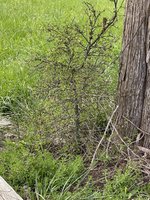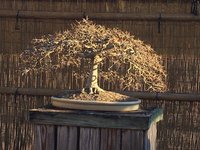You are using an out of date browser. It may not display this or other websites correctly.
You should upgrade or use an alternative browser.
You should upgrade or use an alternative browser.
How about hackberry?
- Thread starter 19Mateo83
- Start date
Frozentreehugger
Masterpiece
I’ve never had one but I know they make good bonsai . There is native ones all of the east of North America . European ones and Chinese . All are used easy to collect and fast growth and good ramification are I believe some of there best traits
RMJoe
Seedling
They do well as bonsai but in my experience they layer poorly. I've seen other people have success, but it's the only species I've had major issues with air layering.
penumbra
Imperial Masterpiece
Ground layering is a pretty sure shot but it could take a year.
Aeast
Shohin
I've been trying to find a good one to collect for years, seems most are root suckers so layering might be the way to go.
19Mateo83
Masterpiece
This one definitely isn’t a sucker, the only reason I’m thinking ground layer is it’s so close to that cedar tree. I haven’t gotten a good close look at it yet, my friend found it in his landscape and sent the picture me. It has a ton of branching and ramification from the looks of it, not a bad size either.
Last edited:
badatusernames
Omono
19Mateo83
Masterpiece
@JudyB your hackberry is very lovely! I see @Dav4 has a pretty sweet one too!
https://www.bonsainut.com/threads/southern-hackberry-project.26898/
https://www.bonsainut.com/threads/southern-hackberry-project.26898/
Dav4
Drop Branch Murphy
- Messages
- 13,106
- Reaction score
- 30,164
- USDA Zone
- 6a
It went to a good friend of mine when I moved north last year. Definitely a good native species to work with if you can find a trunk worth working with.@JudyB your hackberry is very lovely! I see @Dav4 has a pretty sweet one too!
https://www.bonsainut.com/threads/southern-hackberry-project.26898/
19Mateo83
Masterpiece
The one I have permission to dig looks like it could be the beginning of of one like yours.It went to a good friend of mine when I moved north last year. Definitely a good native species to work with if you can find a trunk worth working with.
JudyB
Queen of the Nuts
They are underused for bonsai, but are really wonderful trees to develop. There are differing varieties, but all have small leaves and you can get good ramification. I have had a couple, and they are well worth the effort if you can get a well started collection.
PA_Penjing
Chumono
They have great bonsai attributes and will grow from cuttings and root cuttings easily. Interesting to hear that they don't layer well, I figured all that would go hand in hand. I have dug and started to dig (and then stopped) a handful of them this spring. They all seem to have incredibly thick and deep taproots that make collecting hard/impossible/ruin the trunk line. But definitely nice to have a a deciduous tree that ramifies well and has warty bark.
PA_Penjing
Chumono
Just realizing now you probably have the southern species, where as I have northern (occidentalis). root situation could be different. Seems like the leaves on Southern are smaller and the bark is not as lumpy
SeanS
Omono
- Messages
- 1,240
- Reaction score
- 3,482
- USDA Zone
- 9b
Here in South Africa we have Celtis Sinensis (Chinese hackberry) and Celtis Africana (white stinkwood), both of which grow like literal weeds everywhere! Parks, pavements, open lots, gardens, they’re everywhere! Both are very popular in our local bonsai scene
rockm
Spuds Moyogi
Hackberry make excellent bonsai. I have had several--all Southern Hackberry (Celtis laevegata). They are weeds. You cannot hurt them. I can't imagine trying to air layer one. THere's no reason to. Just dig the thing up, or rather saw it out of the ground. Simply move six inches out from the trunk, find the major roots, saw through them pull the tree up, hose off the field soil and plant in a training container (smaller the better) with good bonsai soil. INsure the nebari remains buried under two or three inches of soil to prevent die back.How does hackberry do for bonsai? I ran across this one in a friends landscape. I’m going to have to ground layer this one. Any one know if these guys root good?
You are likely dealing with regular old common hackberry (celtis Occidentalis), as southern hackberry (Aka sugarberry) doesn't grow that far north. I Sugarberry is susceptible to cold--I got one a long time ago from Guy Guidry (La. collector). It was a spectacular little shohin-sized bonsai. LEaves had reduced to 1/4 inch and less and it has extreme twigging. However, after a few Va. winters (even with protection) it lost all of the fine ramification to freezes.
I currently have a sugarberry I orginally collected in Texas. I planted it in my yard for the last 10 years. I dug it up this spring using the above techniques. In-ground, it also lost ramification every winter, but regained all of it by summer's end. We'll see how it does in a container.
rockm
Spuds Moyogi
Similar threads
- Replies
- 4
- Views
- 523
- Replies
- 6
- Views
- 497
- Replies
- 1
- Views
- 457


